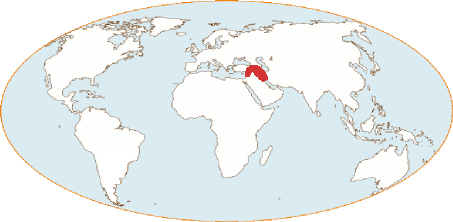Beer and agro-pastoralists in Northern Syria.
The archives of the small Old-Babylonian kingdoms in Syria are exceptional for their accurate and detailed accounting, and above all the perspective offered on a daily life often absent from the Southern Mesopotamia documents. The brewery holds a leading economic and social position. This can be measured by the volumes of grain devoted to beer brewing, the technically defined (grain:beer ratios) beer grades, the socially assigned types of beer, the very fine management of the brewing workshops, and finally the sophisticated brewing techniques.
These Northern Syria archives are exceptional for another reason. They belong to a cultural and geographical sphere dominated by the agro-pastoral life. At the beginning of the 2rd millennium, sheep breeders and wheat-barley growers rubbed shoulders in the Middle Euphrates region. Their livelihoods complement each other, but their lifestyles are in some respects opposed. It is rare to capture in the world's archives the details of this regional organisation for very ancient times.
So, beer is drunk throughout the Upper Habur, the region north of the middle Euphrates valley. In this mixed country of cereal cultivation and extensive sheep and goat herding, beer has traditionally played an important economic role. The region is under Assyrian influence at that time, and the details of the distribution of food and beverage for the royal houses show that superior beer, intended for high-ranking people, is part of the customs. Beer is consumed by all social categories. The cartography of beer is far different from what it will become one or two millennia later when the fermented grain beverage will be the specific drink of the most modest and wine the emblematic drink of the most powerful. In the second millennium B.C., the social hierarchy is measured and embodied by the volume of grains consumed in the form of beer and bread. The access to cereals, in terms of volume and quality, is the essential and common criterion for all societies at that time. For the farming communities, this standard is an integral part of their way of life. What about the communities whose livelihood depend on the sheep, goats and donkeys herding ?
Hence, one question remains unanswered : to what extent are beer and brewing techniques integrated by the semi-nomadic populations of northern Syria, by these sheep breeders and traders using long-distance caravans of donkeys ?
These territories are occupied by pastoralist tribes. It seems, from the examples of the census of Šubat-Enlil or the existence of villages scattered around urban sites (Chagar Bazar), that these semi-nomads maintain economic relations with the farming villages. The result is an osmosis between nomadic pastoralists and sedentary farmers, between two lifestyles and two cultures. The documents we have at our disposal obviously emanate from the urban, administrative, centralising culture, aspiring to political control of the region and relying on a fabric of farming villages.
At the time of the royal archives of Mari, the Bensim'alite or Benjaminite tribes were agro-pastoral. Within them, the groups wâšibûtum practise cereal cultivation[1]. The association between farmers and urban centres is by nature that of beer drinkers. Do the "Bedouin" tribes also practice brewing? The testimonies are very indirect. In possession of large stocks of grain, nothing prevents these Hanaeans from brewing thier own beer. Moreover, beer production is complementary to small-scale farming. Brewing dregs have always been recycled into animal feed.
It is necessary to revise the picture which usually presents Northern Syria as a region where wine is replacing beer. This became partly true after the conquests of Alexander and the Roman Empire. Before that time, beer dominated the social landscape in the region[2].
Our economic archives, which are more representative of day-to-day management, correct the very elitist vision distilled by the royal courts, where wine reigns on the tables as a symbol of economic wealth and diplomatic power. At Tell Leilan, at Chagar Bazaar and at Tell Rimah, batches of documents dealing with wine have been found.In the lower town of Šubat-Enlil for example, 13 tablets belonging to the king's cupbearer record deliveries of wine for worship, the king's table or his wedding[3]. They bear the impression of the royal seal which the cupbearer has, a mark of his prestige and the value accorded to the wine. It is as precious a commodity as gold or silver. But this favour enjoyed by wine in the entourage and the royal ceremonial never eclipses beer, which remains the basic drink.
The populations of these regions have never settled down around a vine! Instead, they have gathered around fields of barley and wheat. They gathered around their granaries and grain silos. The first urban centres attracted nomads because their granaries were full. What did they have to offer? Beer and bread!
In the Middle East, the second millennium is still a formative period for political organisations based on a primitive type of royalty. At that time, beer structured the economy and cemented social relations, because the grains from which beer originated are and remain the only mass-produced material good, accumulated and exchanged among all social groups.
[1] Jean-Marie Durand 1999/2000, Apologue sur des mauverses herbes et un coquin (Orientalis XVII-XVIII, Festschrift G. del Olmo Lete Aula), p. 195.
[2] The wine is present in the archives of the palace of Mari. It is drunk by a limited number of people (royal circle, great stewards, merchants). It is traded between the vineyards of the Mediterranean coast and the inland kingdoms, via the river Euphrates axis. André Finet 1974, Le vin à Mari (Archiv für Orientforschung 25); J.-M. Durand 1982, In Vino Veritas (Revue Asyriologique 76).
[3] Harvey Weiss H. & al. 1990, 1985 Excavations at Tell Leilan, Syria, American Journal of Archaeology 94, pp. 568, 575.



